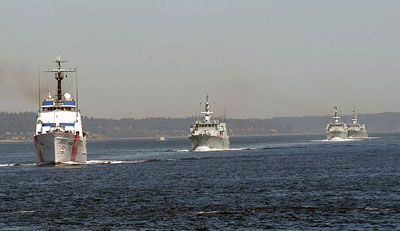Space and the 2000 ship Navyby Taylor Dinerman
|
| The goal is to create a global network of networks that can provide everyone involved with a near real-time, transparent view of what is happening on the surface of the world’s oceans. |
The flow of sensor information into the network will be enhanced by the massive US capability to rapidly process and to extract significant intelligence data. This fact will limit the desire of many nations to join the system or, if they join, to provide anything more than the simplest and most basic information. The new strategy is much more of a political gesture than the product of a naval establishment concerned with fighting and winning wars at sea.
To some extent this makes sense. The US Navy is, in spite of its problems and limits, by far the most powerful one on Earth. A notional Chinese challenge to US supremacy is at least a decade away, and probably more. Seen as a way to legitimate the US’s maritime position, the strategy seeks to anticipate and head off the kind of threat to America’s Navy that the Imperial German High Seas Fleet represented for Britain’s Royal Navy before 1914.
The US Navy will be able to provide its partners with access to information derived from America’s unmatched space-based observation systems. It will also be able to provide a global communications architecture that no other nation can equal. At its most basic, the US could provide a simple terminal and antenna to any partner navy’s ships, which can feed data directly to captains and flag officers.
For example, a local West Africa navy could be informed of the exact location of an illegal fishing vessel and could be guided to an interception. For poor nations seeking to protect and profit from their Exclusive Economic Zones (EEZs), such a network would more than repay the rather modest political and monetary investment needed to become a part of the 2000-ship navy.
These advantages may not be enough to lure more than a few nations into the system. Since the network will, in diverse minor ways, increase overall US military power, nations may be reluctant to contribute. Moreover, any state tempted to join may find itself subject to pressure from any of its neighbors who are fundamentally hostile to America. Rogue states whose leaders are interested in maximizing their capacity to harm the global system will do everything they can to prevent the new system from working.
NATO is already working to integrate simple space sensors into its maritime surveillance effort. In the January issue of Jane’s International Defense Review (IDR), an article describes how the NATO Undersea Research Center (NURC), based in La Spezia, Italy, is “investigating how multi source tracking and fusion techniques exploiting space-based sensors, radar and the Automatic Identification System could help detect and classify anomalous ship behavior.” According to IDR, the principal space sensor is Canada’s RADARSAT. The goal is to develop a system whose software will be able to automatically recognize activities on the high seas that are somehow not “right”. When and if NATO deploys this system, it will be far more oriented towards situational awareness for law enforcement and counter terrorism than towards warfighting.
| TThe Air Force controls the lion’s share of the space development and operations budget. Naturally, it orients its spending towards its own concepts and priorities. |
Space assets provide the US and its allies with a way of gathering the sensor data that many navies will either refuse to provide or could cut off in a crisis. Law enforcement cooperation is relatively easy in peacetime or in the sort of semi-war environment that we seemed destined to live in for the next couple of decades. A robust constellation of modestly-priced space sensors, including ones that are only a little better than RADARSAT’s, will give the US Navy and its close allies an alternative to depending on sensors owned by nations who may not always want to help.
The cost of such a program would probably not be any more than the cost of one of the Navy’s new Zumwalt-class guided missile destroyers, i.e., around $5–6 billion. Under the Defense Department’s current roles and missions setup, the money for such a program would not come from the Navy’s budget but from the Air Force which is the “executive agent” for space. So even if the Secretary of Defense and the leaders of both the Navy and the Air Force were all to agree on the desirability of such a system, it is highly unlikely that these satellites would ever be built and launched other than as a few experiments.
This problem is a recurring one. The Air Force controls the lion’s share of the space development and operations budget. Naturally, it orients its spending towards its own concepts and priorities. The other services can take advantage of these efforts in areas such as communications and navigation, but they find it difficult to push their own priorities and requirements into systems and program that are controlled by another military organization. It is ironic that the US Navy seems to find it easier to cooperate with dozens of foreign navies than to do so with its neighbors in the Pentagon.
